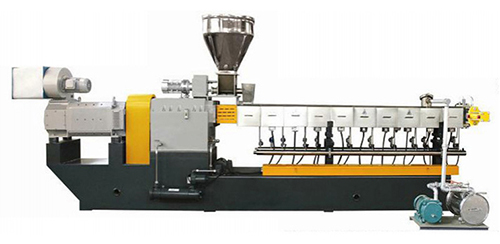Copyright © Shanghai Omega Machinery Co., Ltd. All rights reserved.
What are the elements in twin screw extruder?
Jan 08,2024
1. Feeding System:
Hopper: The material to be processed is introduced into the extruder through a hopper.
Feeding mechanism: A mechanism, such as a feeder or a screw conveyor, is used to convey the material from the hopper to the extruder.
2. Twin Screws:
The heart of the twin screw extruder is the pair of intermeshing screws. These screws can have different profiles (e.g., co-rotating or counter-rotating) and are responsible for conveying, compressing, and melting the material as it moves along the extruder barrel.
3. Barrel:
The barrel surrounds the screws and provides a confined space for the material to undergo various processing stages.
The barrel is typically divided into several zones, each with its own temperature control to optimize the processing conditions.
Electric or fluid-based heating elements are used to control the temperature of the barrel. Different temperature zones along the barrel allow for specific processing steps, such as melting, mixing, and shaping.
Cooling systems may also be present to control the temperature in certain sections.
5. Drive System:
The twin screws are driven by a motor, which provides the necessary power for the extrusion process. The drive system is crucial for controlling the speed and torque of the screws.
6. Venting System:
Some extruders have venting ports to allow the escape of volatile gases or moisture from the material being processed. This is particularly important in certain applications, such as polymer processing.
7. Die and Adapter:
The die is located at the end of the extruder barrel and shapes the extruded material into the desired form.
An adapter connects the extruder barrel to the die and helps in transitioning the material from the screw configuration to the final shape.
8. Control System:
A control system, often computerized, is used to monitor and adjust various parameters, such as screw speed, barrel temperature, and material flow. This ensures precise control over the extrusion process.
9. Screen Changer (optional):
In some applications, a screen changer may be included to filter impurities from the material before it reaches the die.
These elements work together to facilitate the processing of raw materials into the desired product through the extrusion process. The specific design and features of a twin screw extruder can vary based on the intended application and the materials being processed.
Prev News Next News
- Information
- What causes the uneven surface and poor gloss of the sheet during the sheet extrusion process? How can it be solved?
- Why does the cooling process for profile extrusion become unbalanced?
- What countermeasures can be taken to improve the dimensional and positional accuracy of profiles during the profile production process?
- How should profile molds be cleaned and maintained?
- What are the corresponding solutions to the phenomenon of grooves and pits on the surface of profiles?
- How should the raw materials be selected in the formula for PVC surface skin core layer microcellular foamed extruded profiles?
- How should the production process of biaxially oriented polyethylene terephthalate (BOPET) film be controlled?
- How should the longitudinal and transverse stretching be controlled when producing biaxially oriented films by the flat film method?
- How should the counter-rotating conical twin-screw extruder be operated for no-load test run?
- What are the characteristics of extrusion blow molding molds?
- Contact Us

-
Shanghai Omega Machinery Co., Ltd.
Add.: No.168 Hualian Road, Putuo District, Shanghai City
Contact: Nina
Tel.: +86-021-69921527
Mobile: +86-15021464410
Fax: +86-021-69921567
E-mail: omegajessica@163.com;965425705@qq.com
WeChat No.: 1131449532
-
